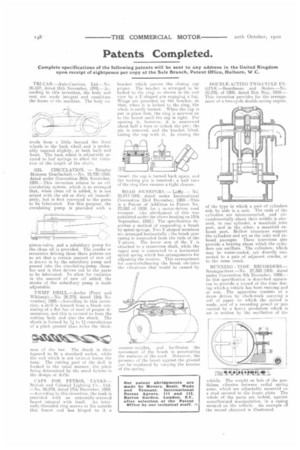Patents Completed.
Page 20

If you've noticed an error in this article please click here to report it so we can fix it.
Complete specifications of the following patents will be sent to any address in the United Kingdom upon receipt of eightpence per copy at the Sale Branch, Patent Office, Holborn, W.C.
TRI-CAR.—Auto-Carriers, Ltd.--No. 26,5a7, dated 16th November, 1909.—According to this invention, the body and seat are made integral and constitute the frame of the machine. The body ex
tends from a little beyond the front wheels to the back wheel and is preferably tapered slightly, at both back and front. The back wheel is adjustably secured to leaf springs to allow for variation of the length of the chain.
OIL CIRCULATION. — Daimler Motoren Gesellechaft.—No. 12,720j1910, dated under Convention 30th November, 1909.—This invention relates to an oilcirculating system, which is so arranged that, when clean oil is added, it is not mixed with the old or dirty oil immediately, but is first conveyed to the parts to be lubricated. For this purpose, the circulating pump is provided with a
piston-valve, and a subsidiary pump for the clean oil is provided. The cranks or eccentrics driving these three pistons are so set that a certain amount of new oil is drawn in by the subsidiary pump and passed into tr)e circulating-pump chamber and is then driven out to the parts to be lubricated. To allow for variation in the amount of new oil added, the stroke,. of the subsidiary pump is made adjustable.
TWIST -DRILL.—Accles (Pratt and Whitney).—No. 26,278, dated 12th November 1909.—According to this invention, a drill is formed from a blank consisting of a flat bar of steel of proper dimensions; and this is twisted to form the cutting body and also the shank. The shank is hinted by 1 to ls convolutions of a pitch greater than twice the thick
ness of the bar. The shank is then tapered to fit a standard socket, while the end which is not twisted forms the tang. The Cutting part of the drill is formed in the usual manner, the pitch being determined by the usual factors in the design of drills.
CAPS FOR PETROL TANKS.— British and ColonialLighting Co., Ltd. —No. 29.578, dated 17th December, 1909. —According to this invention, the tank is provided with an externally-screwed faucet integral with itself. An internally-threaded ring screws or fits outside this faucet and has hinged to it a bracket, which carries the closing cap proper. The bracket is arranged to he locked to the ring, as shown in die end view by a U-shaped pin engaging a lug. Wings are provided on the bracket, so that, wheo it is locked to the ring, the whole is easily turned. When the cap is put in place first, the ring is screwed on to the faucet until the cap is tight. For opening it, however, it is unscrewed about half a turn to unlock the pin ; the pin is removed, and the bracket lifted, taking the cap with it. In closing the vessel, the cap is turned back again, and the locking pin is inserted ; a half turn of the ring then ensures a tight closure.
ROAD SWEEPERS. — Laffiv. -.NO. 23,017-1909, dated under International Convention 23rd December, 1908.—This is a Patent of Addition to Patent No. 22,933 of 1909. for a motor-driven road
sweeper. An abridgment of this was published under the above heading on 15th September, 1910.) The specification describes a method of suspending a brush by spiral springs. Two Y-shaped members arc arranged horizontally ; the brush gear casing is suspended from the tails of the I-pieces. The lower arm of the I is attached to a. transverse shaft, while the upper arm is connected to a horizontal spiral spring which has arrangements for adjusting the tension. This arrangement for counterbalancing the brush obviates the vibrations that would be caused by counter-weights, and facilitates the movement of the brush in penetrating the surfaces of the road. Moreover, the pressure of the brush against the ground can be regulated by varying the tension of the spring. DOUBLE-ACTING TWO-CYCLE ENGINE—Beardmore and Stokes.---No. 30,278, of 1909, dated 31st May, 1910.— This invention provides for the arrangement of a two-cycle double-acting engine.
of the type in which a pair of cylinders side by side is a unit. The ends of the cylinders are interconnected, and circumferentially about their middle is situated, in one cylinder, a manifold inlet port, and in the other, a manifold exhaust port. Hollow trunnions support the cylinders and act as the inlet and ex• haust passages. These trunnions also provide a bearing about which the cylinders can oscillate. The 'cylinders, which may be water-cooled, are directly con, fleeted to a pair of adjacent cranks, or to the same crank.
RUNNING TJAIF. RECORDERS.— Haumgaertner.—No. 27.393/1909, dated under Convention 9th December, 1908.-In this specification is described apparatus to provide a record of the time during which a vehicle has been running and at rest. The apparatus consist, of a, drum driven by clock-work carrying a roll of paper on which the record is made, and of a recording pencil or pen carried by a heavy pendulum which is set in motion by the oscillation of the vehicle. The weight or bob of the pendulum vibrates between radial spring arms, which are adjustably mounted on a stud secured to the frame plate. The whole of the paste are locked, against unauthorized manipulation, in a casing secured on the vehicle. An example of the rec.ord obtained is illustrated.




















